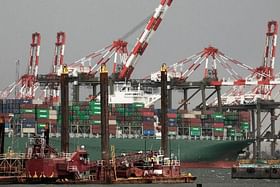The port is focusing on various strategies to increase its capacity utilisation — including a tariff freeze, emphasis on coastal shipping for competitiveness, land allocation for port-led industrialisation, and expanding its cargo basket.
Paradip Port Trust, located in Odisha, aims to become the leading port of India by handling 150 million tonnes of cargo this fiscal year.
The plan is to raise its capacity to 500 million by 2047, according to its chairman, P L Haranadh.
Currently, the port is second among the 12 major ports in India, handling 135.36 million tonnes of cargo this year.
The top port for major ports is Kandla in Gujarat, which handled only 2.5 million tonnes more than Paradip, Haranadh added.
He expects Paradip Port Trust to become the leader in terms of cargo handling if everything goes as per plan.
The port is focusing on various strategies to increase its capacity utilisation — including a tariff freeze, emphasis on coastal shipping for competitiveness, land allocation for port-led industrialisation, and expanding their cargo basket, reports Times of India.
Major Expansion Plans
The trust is targeting a capacity increase of 400 million tonnes by 2030, and a total of 500 million tonnes capacity by 2047.
The port has mechanised 80 per cent of its berths and plans to become a 100 per cent mechanised facility by 2030 with the full automation of its existing four semi-mechanised berths.
The port is also focusing on coastal shipping, aiming to increase their current 74 million tonnes of capacity to 100 million by 2030.
To achieve their goals, the authorities have allocated Rs 10,000 crore — including a capital expenditure of Rs 3,000 crore for Western Dock — a key project that will add 25 million tonnes of capacity.
As part of their port-led industrialisation initiatives, the authorities have allocated 769 acres of land to various industries.
This is expected to help generate additional 50 million tonnes of cargo traffic to the port.
Further, authorities have carried out a trial for moving gypsum to a western port and are exploring other cargo opportunities, with plans to diversify their cargo basket — which currently focuses on crude, iron, and coal.
The authorities also plans to set up an LNG/CNG refilling centre on a PPP model to promote eco-friendly transportation and develop Paradip into a hydrogen hub, with an exclusive facility for handling green hydrogen and green ammonia.
With the DPR almost ready, the project is expected to be awarded in the next financial year, Haranadh stated.
Haranadh believes that the major ports of the country will continue to flourish, and the share of these facilities in total traffic has increased by 1 per cent in the last fiscal year.
As per the report, the major ports handle 55 per cent of the total traffic, while 200 non-major ports manage 45 per cent of the country’s total export-import traffic.
All major ports together handled approximately 795 million tonnes of export-import traffic, registering a 10 per cent growth in the last fiscal year.


